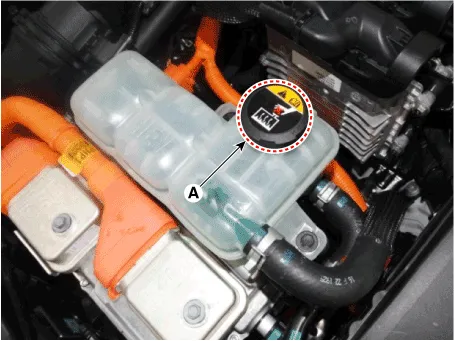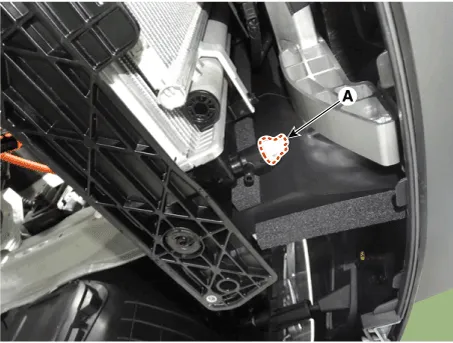Hyundai Ioniq (AE): Hybrid Motor Cooling System / Coolant. Repair procedures
| Changing the Coolant and Performing Air Bleeding |
Never remove the cap while the engine is hot. When you remove the cap from the reservoir, hot coolant may spew out due to the high pressure, causing serious injury. |
When you pour the coolant, be sure to close the relay box cover. Also, make sure that you don't spill the coolant on electrical components or the paint on the vehicle. If you spilled it, wipe it out immediately. |
| 1. | Remove the reservoir cap (A) to drain the coolant quickly.
|
| 2. | Remove the undercover. (Refer to Engine Mechanical System - "Engine Room Undercover".) |
| 3. | Loosen the inverter radiator drain plug (A) and drain the coolant.
|
| 4. | Tighten the inverter radiator drain plug again. |
| 5. | Drain the coolant from the reservoir and clean the tank. |
| 6. | Fill the radiator with water through the reservoir cap and mount the radiator cap.
|
| 7. | Operate the electric water pump (EWP) using the GDS in the IG ON state.
|
| 8. | Repeat the steps 1 - 7 until the drained water becomes clear. |
| 9. | Pour the mixture of antifreeze and water (45 - 50%) into the radiator through the reservoir cap. At this time, press the upper / lower hoses on the radiator so that the air can get out easily.
|
| 10. | Operate the EWP using the GDS while IG ON.
|
| 11. | Once the EWP operates and circulates the coolant, fill the coolant to a level between MAX and MIN.
|
| 12. | If the operating sound of the EWP becomes smaller and no air bubble is seen in the reservoir, stop the air bleeding.
|
| 13. | Stop the EWP and fill the coolant to the MAX level and mount the reservoir cap. |
Removal1.Remove the 12 V battery (-) cable.2.Remove the undercover.(Refer to Engine Mechanical System - "Engine Room Undercover".)3.Drain the coolant from the hybrid cooling system.
Component location1. HPCU (Hybrid Power Control Unit)(LDC+MCU+HCU+Reservoir)2. Hybrid drive motor3. Hybrid starter generator (HSG)4. Electrical radiator5.
Other information:
Hyundai Ioniq (AE) 2017-2022 Service & Repair Manual: A/C Pressure Transducer. Description and operation
DescriptionThe A/C Pressure Transducer (APT) converts the pressure value of high pressure line into voltage value after measuring it. By converted voltage value, engine ECU controls the cooling fan by operating it high speed or low speed. Engine ECU stops the operation of the compressor when the temperature of refrigerant line is very high or very
Hyundai Ioniq (AE) 2017-2022 Service & Repair Manual: Auto Defoging Actuator. Repair procedures
Inspection1.Turn the ignition switch OFF. 2.Disconnect the auto defogging connector. 3.Verify that the auto defogging actuator operates to the open position when connecting 12V to terminal 3 and grounding terminal 4. Verify that the auto defogging actuator operates to the close position when connected in reverse.
Categories
- Manuals Home
- Hyundai Ioniq Owners Manual
- Hyundai Ioniq Service Manual
- Parking Distance Warning system (Reverse) malfunction, Check Active Air Flap System
- Fuel Pump Control Module (FPCM). Description and operation
- Components and components location
- New on site
- Most important about car







